Content [show]
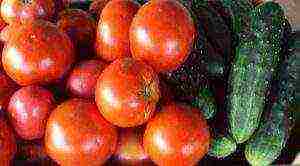
The combination "cucumbers-tomatoes"For the vast majority of people, it is familiar and connected
with their frequent joint stay in fresh salads and winter preparations. It has already become a kind of "vegetable classic".
The question of whether it is possible to grow cucumbers and tomatoes in the same greenhouse worries many. Is there any benefit from the close proximity of these crops in gardening? How to be if the greenhouse is alone, and you want to get a harvest of both those and other vegetables?
…
Long road to popularity
In any living organism, be it a plant or an animal, nature has a certain genetic code that determines its properties and requirements for the environment. 
Breeding work with seed material carried out for many decades has made it possible to change and improve the appearance and taste of vegetables.
But it is very rarely given the opportunity to change their requirements for the growing environment, although some plants can adapt to changing conditions in nature through mutational processes.
Hot India with high air humidity - homeland of cucumber... In the wild, it still grows in those places.
Images of a cucumber have been found on frescoes in Ancient Egypt and Greek temples. A vegetable known in such ancient times in other countries in Russia was first mentioned in printed sources in the 16th century.
Presumably, the cucumber came to us from East Asia, but it tasted amazingly and became a truly national product.
Bountiful harvests of cucumbers are grown in most of the country - in greenhouses and on the ground. And then, with love and diligence, cucumbers are harvested for eating all year round.
Wild tomatoes were first discovered in South America during the expedition of Christopher Columbus, and their seeds were brought to Europe because of the decorativeness of the bushes. At home, tomato thickets were found on dry and ventilated mountain slopes. The climate of those places was ideal for tomatoes - mild, temperate, with occasional heavy rains. The 24-hour temperature ranged from 20 to 25 degrees Celsius.
REFERENCE: In Holland, France and Germany, tomatoes were grown in the greenhouses of wealthy people, landed for decoration in gardens and near gazebos. Their fruits were considered poisonous. And only in 1811, the German Botanical Dictionary posted on its pages information that tomatoes can be eaten.
Tomato seeds came to Russia under Catherine II, but only at the beginning of the 19th century they began to be grown in the southern regions of the country as edible crop and get good harvests.
Photo
In the photo below you can see cucumbers and tomatoes in one polycarbonate greenhouse:
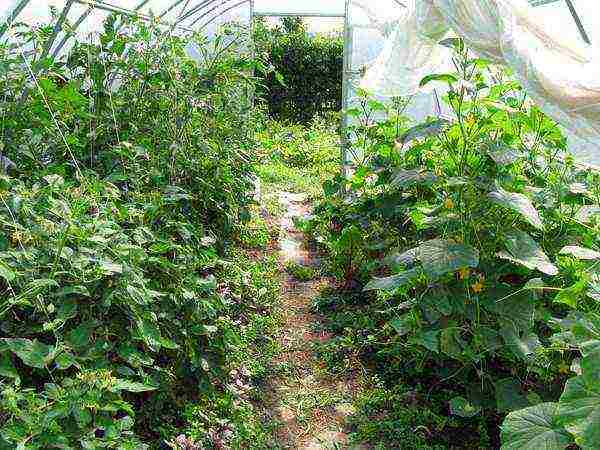
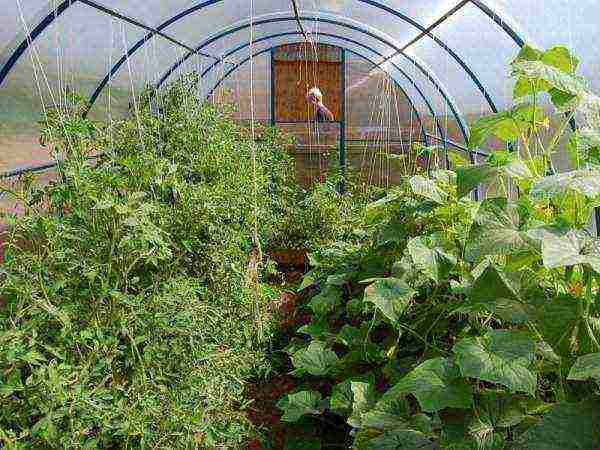
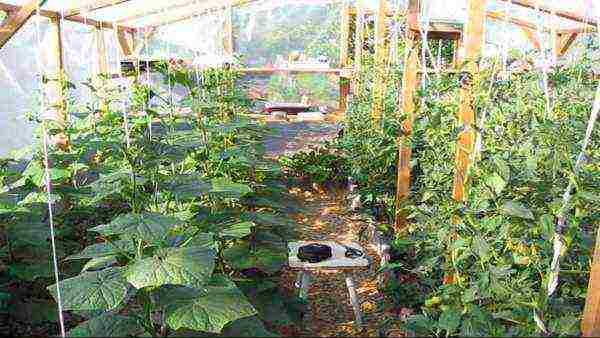

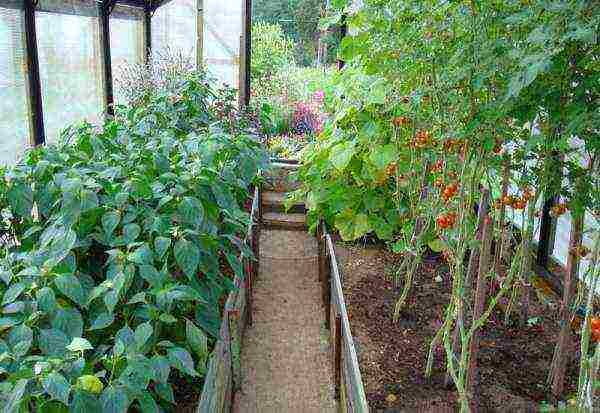
Capricious neighbors
If there is only one greenhouse, but really want to get a harvest of those and other favorite vegetables, the desire to experiment often wins. Desperate summer residents and gardeners boldly divide the greenhouse area into two adjacent zones and plant tomato seedlings on one, and cucumber seedlings on the other. What is the compatibility of cucumbers and tomatoes in the same greenhouse? Let's try to answer this question.
During the summer, both crops in a polycarbonate greenhouse receive the same care and grow in the same microclimate with the same conditions.With special diligence, the owners do not remain without a crop, but they will not have to be called abundant.
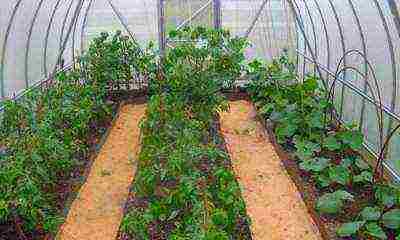 The reason for this is all the same genetics that require different conditions for each type of vegetables close to those in which their distant wild relatives once grew.
The reason for this is all the same genetics that require different conditions for each type of vegetables close to those in which their distant wild relatives once grew.
For cucumbers the optimal conditions for favorable growth will be a hot atmosphere, with high, up to 90-100% humidity.
Drafts are detrimental to this culture. Moreover, wet "bath" procedures significantly increase the yield of cucumbers. To do this, in warm weather, the bushes are well shed under the root and over the leaves, the paths and walls of the greenhouse are abundantly watered.
Then the doors are tightly closed and withstand this mode for 1-1.5 hours, after which the greenhouse is opened for ventilation. The leaves of cucumbers are very large, such procedures allow them to safely cope with the evaporation of moisture, preventing drying out.
With insufficient moisture, cucumbers grow tasteless, ugly in shape.
Tomatoes feel better in a different microclimate. Like their cousins in the wild, they prefer low humidity, 40 to 60%. They are very fond of airing.
Watering tomatoes is enough on average 2 times a week. In a too humid environment, the pollen in the flowers sticks together, the fruits in the brushes are not tied. The consequence of high humidity in the greenhouse is always the appearance of fungal and bacterial diseases of tomatoes.
The yield of vegetables decreases, the taste of the fruits deteriorates, and cracks appear on them.
With such different requirements, any compromise will mean a situation where both sides lose, so it is worth trying to change the conditions by setting up separate zones in capital greenhouses. 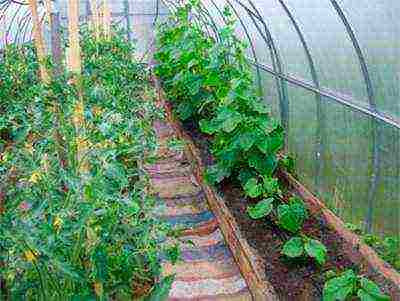
Divide living space: growing cucumbers and tomatoes in one greenhouse
Divide the greenhouse into two parts you can partitions from slate, plastic curtains, plywood. Cucumbers are planted in the far "room" where the window is located. Here they will be protected from drafts, it will be possible to provide them with high humidity.
Tomatoes will be planted in the square near the greenhouse door. It is possible by keeping the door open at all times to maintain a relatively low humidity and temperature in the greenhouse.
In order to prevent water from flowing from one section to another, it will be necessary to make a barrier to separate the soil to a depth.
Now you can pamper tomato bushes with good feeding, which they love very much. This is especially true for tall varieties of tomatoes.
For cucumbers in a personal "room" abundant water treatments and high humidity are provided without much harm to neighbors. And tomatoes - generous watering with warm water, strictly under the root, avoiding contact with the leaves.
For lovers of the process itself, working with plants, planting tomatoes and cucumbers in a greenhouse will bring pleasure even if the vegetable harvest is not huge.
The most important thing is that with any method, there will be pimpled green cucumbers and poured raspberry tomatoes in the basket.
ATTENTION: Experienced gardeners, determined to get the best yield possible, will adhere to strict rules to create optimal conditions for each crop. They will grow all vegetables in a separate greenhouse unless they need the same environment for growth. For example, the same cucumbers and bell peppers or melon. Or tomatoes and various green vegetables.
So, is it possible to plant cucumbers and tomatoes in a greenhouse? The answer to the question of how to plant, when to plant, as well as the decision of which method of growing cucumbers and tomatoes in a greenhouse to choose, whether it will be joint or not, remains the right of every gardener. If fussing in the garden is more desirable than the opportunity to get more harvest - experiments are just for you!
Useful video
A video about growing cucumbers and tomatoes in a greenhouse, see below:
Tomatoes and cucumbers are crops with diametrically opposite requirements for care, watering, and temperature conditions. However, many gardeners plant them side by side in closed ground, where the conditions for all plants are the same. Is it possible to plant cucumbers and tomatoes in the same greenhouse and how to do it correctly without harming the plants? It is possible, but for this you need to study the conditions of a competent neighborhood.
Should I plant tomatoes and cucumbers together?
Alas, not every gardener has the opportunity to install separate greenhouses for each of the crops on his site, but I really want to get an early harvest of vegetables. That is why tomatoes and cucumbers have to be grown in the same greenhouse, planted together, dividing them only by a path between the ridges. Do tomatoes and cucumbers grow well as neighbors? It is good if you adhere to some rules of their cultivation.
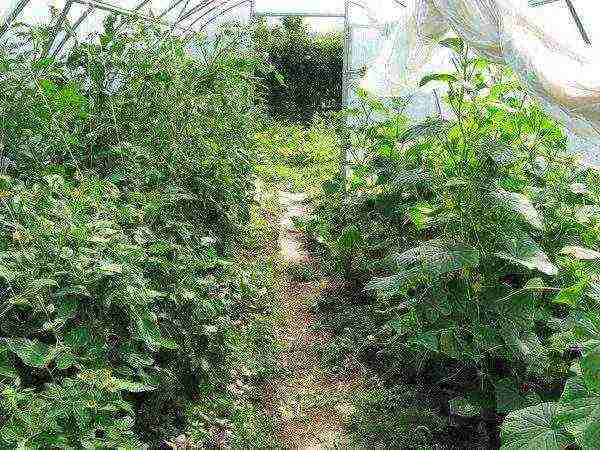
Neighborhood of cucumbers and tomatoes
Conditions for growing tomatoes
Vegetables can grow quite favorably in one area, you just need to create suitable conditions for both. In addition to the generally accepted principles of care, tomatoes and cucumbers have their own requirements for the watering regime and the level of humidity.
In order to grow healthy and abundantly fruiting tomatoes in a greenhouse, a number of conditions must be observed:
- Choose hybrid varieties bred for cultivation in greenhouse conditions.
- Qualitatively prepare the room and soil before planting seedlings.
- Monitor temperature after disembarkation.
- Weed regularly, apply top dressing.
- Carry out work to prevent morbidity.
- Remove stepsons and lower leaves.
- Water moderately
- Help in self-pollination.
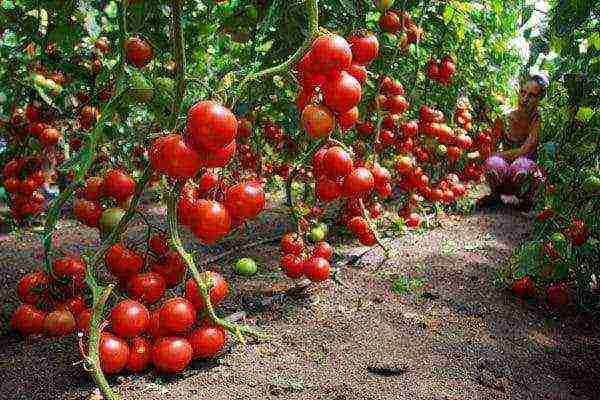
With proper care, the yield of tomatoes increases significantly
When choosing tomato varieties, give preference to F1 hybrids. They are undemanding to care for, adapted to temperature fluctuations, disease-resistant, high-yielding. These varieties are: Eupator F1, Fatalist F1, Gilgal F1, Westland F1, Sprinter F1, Juggler F1, from cherry tomatoes - Cherry Blosem F1, Sweet Cherry F1.
Before planting seedlings, the greenhouse should be disinfected, removed 20-30 cm of soil from the beds and treated with copper sulfate. It is very important to avoid sudden temperature fluctuations in the greenhouse, for this you need to ventilate the room.
The soil in the greenhouse must be cleaned of weeds and loosened, improving its air permeability. Tomatoes need additional feeding, in addition to manure and droppings, experienced vegetable growers suggest using superphosphate.
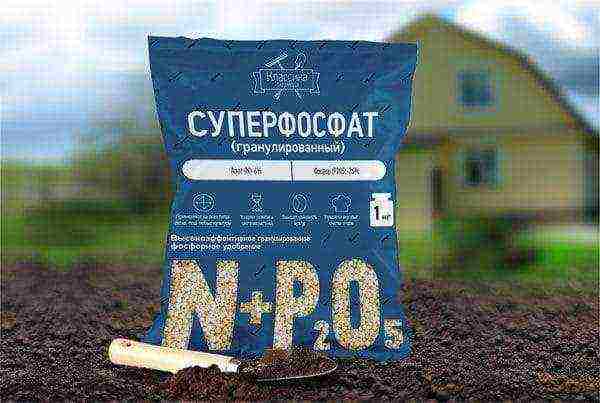
Superphosphate is a common fertilizing among farmers.
Tomatoes do not tolerate waterlogging, they should be watered approximately once every seven days strictly at the root. Timely removal of the lower leaves will add extra aeration, and pruning the stepchildren will help the plant gain vigor.
To stimulate the formation of ovaries, artificial pollination of tomatoes can be carried out; for this, in the morning you just need to shake the bush by the trunk.
High-quality care of tomato seedlings after planting in closed ground is the key to obtaining a rich harvest. Tomatoes are a thermophilic and very demanding culture. In a comfortable microclimate, they grow and ripen earlier, give 2-3 times more harvest than outdoor ones.
Simple rules for growing tomatoes
Features of greenhouse cucumbers
The greenhouse microclimate is ideal for the cultivation of cucumbers. Abundant watering and warmth are important to them, they bloom and tie at a temperature of 23-30 degrees and high humidity. Such conditions are completely opposite to those in which greenhouse tomatoes are grown. This should be taken into account when planting cucumbers and tomatoes in the same greenhouse.
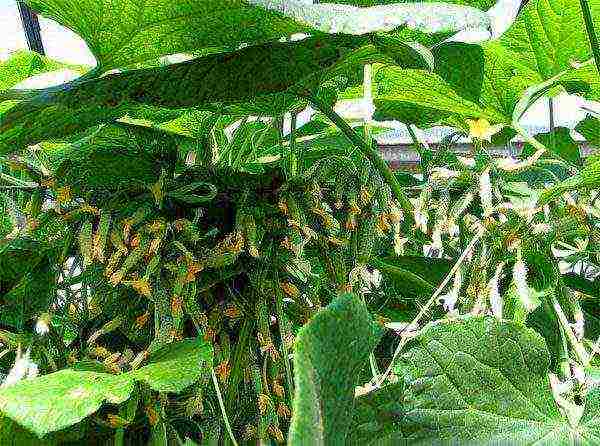
Cucumbers are actively tied in warmth and humidity.
Monitoring of the temperature regime when growing cucumbers is a must! A sharp jump in temperature can be detrimental to the crop, and sometimes to the entire garden.
Temperature norms
Greenhouse cucumber varieties have a number of features:
- able to self-pollinate (parthenocarpic varieties);
- have a thin skin and are suitable for use in any form;
- bear fruit abundantly;
- some varieties have the ability to regulate branching, which helps to avoid thickening of the plantings;
- resistant to many diseases.
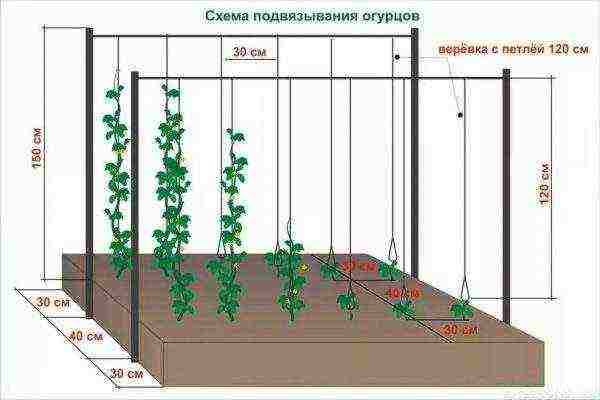
Garter pattern
When choosing seeds, you should give preference to hybrid varieties such as Hercules F1, Annushka F1, Emelya F1, Druzhnaya family F1, Zozulya F1. Hybrid varieties are distinguished by their hardiness and high yields.
Cucumbers attract with their unpretentious care, special requirements are:
- Watering: before the appearance of fruits once every three days, and after - once a day.
- Blinding the lower shoots.
- Control over the humidity level - not less than 85-90%.
- The soil should be permeable, mostly loamy.
- When planting, seedlings do not need to be buried, unlike tomatoes.
Video: Growing greenhouse cucumbers
Feasibility of planting together
When asked whether it is possible to grow both cucumbers and tomatoes in a greenhouse, any experienced vegetable grower will answer that joint cultivation of vegetable crops with opposite care requirements is undesirable. Most refuse such an undertaking, considering it a useless waste of time and effort.
However, if there is no longer an opportunity to get an early harvest, then cucumbers and tomatoes can be planted in the same greenhouse. And plants will be able to comfortably coexist in the same space if you correctly think over a planting plan in the existing territory.
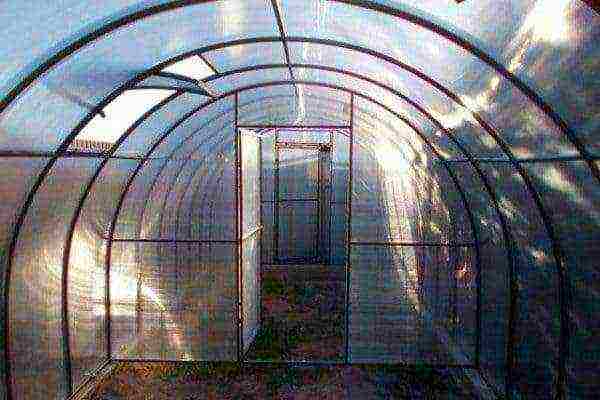
The partition will create two separate areas for vegetables.
Requirements for joint planting of cucumbers and tomatoes:
- Planting vegetables in different parts of the greenhouse. There should be vents or doors next to the tomatoes for frequent ventilation.
- Additional partition. Some growers make a polycarbonate wall or film curtain inside the greenhouse, zoning the space for each crop.
- If there are three beds in the greenhouse, tomatoes should be planted in the central one for better ventilation, and cucumbers should be planted where the air circulates least.
- Dividing the soil between vegetables using a curb tape or a piece of slate.
- Organization of drip irrigation for tomatoes, for example, dig a plastic bottle with a cut off bottom under each bush. Refill the bottle as the water decreases.
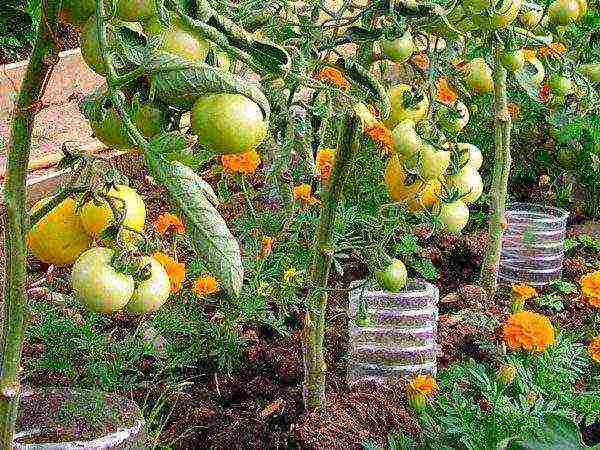
With the help of drip irrigation, water goes directly to the roots and in the required amount
Greenhouse zoning will greatly facilitate the joint cultivation of cucumbers and tomatoes. Plants will grow and bear fruit productively without interfering with each other's space.
Rules for growing plants in one greenhouse
Having decided to plant tomatoes and cucumbers in one polycarbonate greenhouse, you should study in advance the features of their cultivation and the secrets to increase yields. Crops are able to grow well in one area, you just need to create for each of them its own "ideal" microclimate.
When to plant cucumbers and tomatoes
Before planting cucumbers and tomatoes in the same greenhouse, it should be properly prepared. You can start preparing from April, equipping the beds, taking into account the basic requirements of crops. For cucumbers, high ridges (25-30 cm) with generously fertilized soil and a prepared trellis are better suited. Tomatoes, on the other hand, need standard low beds with loose, non-acidic soil containing sand.
The right time for planting cucumbers in a greenhouse is when the temperature of the soil and air warms up enough (18-20 degrees). It is very important to consider the region and temperature conditions in which you live.

Moon calendar
So, for example, in the northern regions the greenhouse warms up later than in the southern ones, therefore, planting is carried out later. The only exceptions are greenhouses with artificial heating, in which vegetables can be grown year-round.
The best month for planting cucumbers is May.They can be planted in holes with seeds or seedlings. When germinating with seeds, the plants will be strong, but if the temperature is not observed, the seeds can rot in the soil.
Video: Terms and rules for planting cucumbers in a greenhouse
Rules for planting seedlings in a greenhouse
Cucumber seedlings are planted in a greenhouse when 3-4 leaves appear on the sprout. When planting seedlings, cucumbers can be sick for a long time, since they do not tolerate transplanting well and they need time to adapt to new conditions.
When disembarking, you must:
- Consider the landing pattern. Plant in a checkerboard pattern or in a line, at a distance of 40-50 cm.
- Tie up plants. The elongated trunk with ovaries is tied with twine or twine and fixed to the trellis.
- Water only in the root zone, constantly loosen the soil between crops.
- Monitor temperature and air humidity. Daily watering and high temperatures are required.
- Harvest in a timely manner, prevent overgrown fruits from rotting.
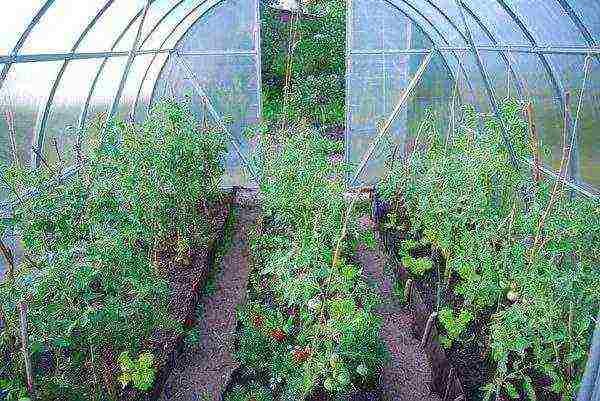
Crop distribution example
Tomatoes should be planted in prepared soil. It is possible to prepare the soil for tomatoes since the fall, having previously disinfected it with copper sulfate or a manganese solution. The ideal precursors for tomatoes are green manure plants (mustard, watercress), which will loosen and saturate the soil with the necessary trace elements.
Tomato seedlings are planted in a greenhouse 50 days after germination, when the root system is formed and the plant is strong. Disembarkation dates are April-May. The air temperature of the greenhouse must be at least 20-25 degrees, and the soil temperature must be at least 15 degrees.
Experienced vegetable growers, before planting seedlings, recommend doing the following:
- hardening, carrying seedlings to the street or balcony;
- remove the lower leaves before direct planting;
- process the sprouts with a solution (boric acid 1 gram + 1 liter of water).
When planting, it is important to deepen the seedlings by 20-25 cm into the ground and maintain a distance of 30-40 cm between them.
Should I add pepper
Many vegetable growers, growing cucumbers and tomatoes in the same greenhouse, plant bell peppers there. It can be called a universal neighbor for one and another culture. Pepper, like a tomato, belongs to the nightshade family, so it is quite comfortable for them to be in a common greenhouse. In addition, tomatoes produce an aphid repellent that annoys peppers.
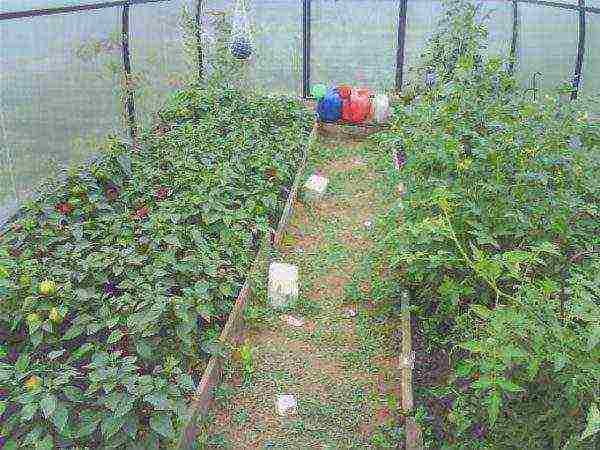
Pepper and tomatoes "coexist" quite favorably
Pepper grows well in a greenhouse with cucumbers, as it has similar growing conditions. They are equally warm and moisture-loving, do not like airing. Therefore, pepper seedlings can be freely planted next to the cucumber. The only difference is the frequency of watering; peppers need to be watered less frequently than cucumbers.
When planting peppers in a common greenhouse, it is necessary to plan the location of the plantings in advance. Peppers do not like darkening, so tall tomatoes and cucumbers should be placed along the edges of the pepper ridges.
The bottom line is that peppers can be grown with other crops in the greenhouse, and quite productively. Pepper is a rather unassuming crop that grows happily in a common area with tomatoes and cucumbers.
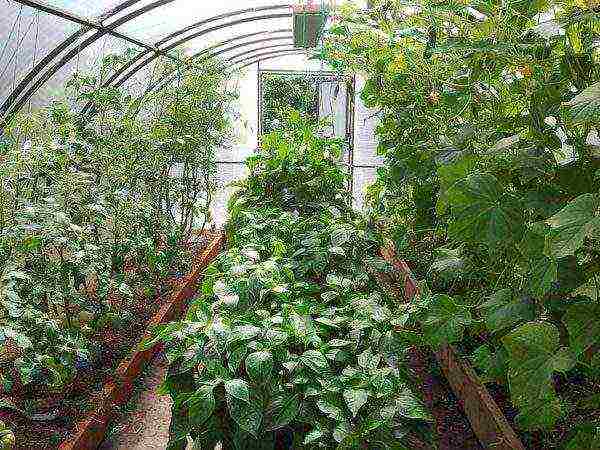
Neighborhood in one greenhouse of three crops
Care tricks: how to increase yields
A novice vegetable grower, before growing tomatoes and cucumbers in the same greenhouse, should study the recommendations for caring for crops from gardeners who have experience of such plantings. After all, there are many simple ways to significantly increase the yield of greenhouse vegetables.
To increase yields, you should:
- Choose the right seeds for indoor cultivation.
- Before planting seedlings, plant green manure plants that can enrich the soil with organic matter.
- Timely remove stepchildren and lower leaves of tomatoes, blind the lower nodes of cucumbers.
- Help the plants with additional pollination by tapping or shaking the bush.
- Mulch the soil under the tomatoes with hay, straw, or last year's tomato tops.
- Water the plants with water at room temperature, observing the watering regime for each crop.
- Carry out preventive work to prevent morbidity (for example, marigolds planted next to tomatoes can scare off pests and fight late blight).
- Feed the plants regularly according to the tables given.

Top dressing of tomatoes
Video: how to properly place different vegetables in the same greenhouse
Before growing cucumbers and tomatoes in the same greenhouse, you should carefully study the required care conditions and the rules for the location of the beds for each crop. It is necessary to organize a greenhouse space taking into account the requirements of each type of vegetables.
Video: joint cultivation of cucumbers and tomatoes in greenhouses
Video: Joint planting of peppers and cucumbers
Video: Watering for joint plantings
Any, even the most incompatible vegetables, can coexist on the same territory. It is important to find an approach and take into account the requirements of each type. By providing the most suitable conditions for each of the vegetable crops, you can grow strong and generously fruiting plants that will delight you with a harvest of your favorite vegetables.
The possibilities of most gardeners are significantly limited by the small area of \ u200b \ u200bplots and the presence of only one greenhouse on them, which you want to use to the maximum. Many gardeners are wondering if it is possible to plant tomatoes and cucumbers together in the same greenhouse: how harmful is such a "neighborhood" and will joint cultivation benefit these crops?
Feasibility of joint landing
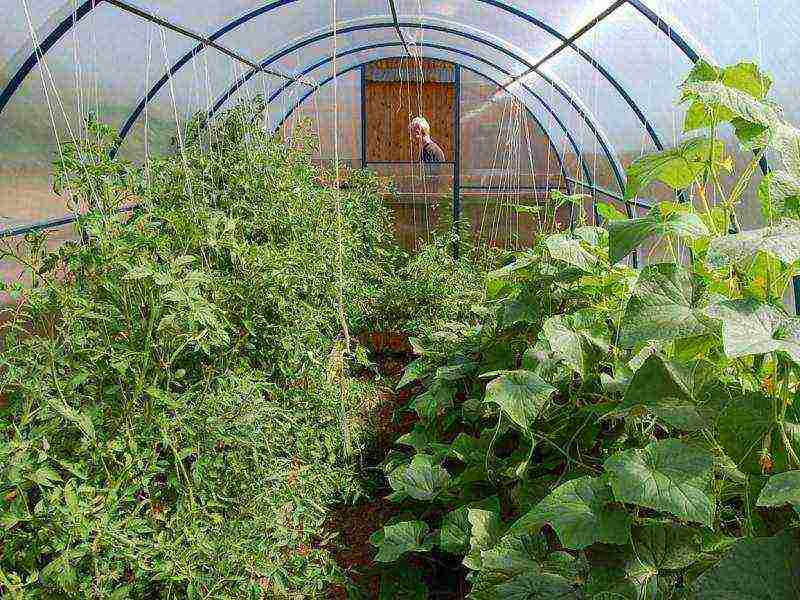
Experts do not recommend growing tomatoes and cucumbers in the same greenhouse if you want to get a good harvest. It's all about the radically different needs of these crops for illumination, humidity, air quality and watering.
By creating ideal conditions for the growth of a tomato, you will stop the development of cucumbers, and vice versa. So what are the needs of these crops, and how can the atmosphere in the greenhouse be optimized so that they can grow side by side?
Cucumber needs
Cucumbers are very moisture-loving plants that require frequent and abundant watering with warm, settled water, combined with spraying the leaves. The humidity in the greenhouse should be at least 85% - only then this capricious culture will thank you with a generous harvest.
What else do cucumbers need in a greenhouse? The optimum temperature for the development of plants and the formation of ovaries is from 22 to 28 degrees, they do not like drafts and frequent ventilation. In addition, the crop requires regular nitrogen fertilization.
So, cucumbers need constant dampness and absence of drafts, what do tomatoes need?
Needs of tomatoes
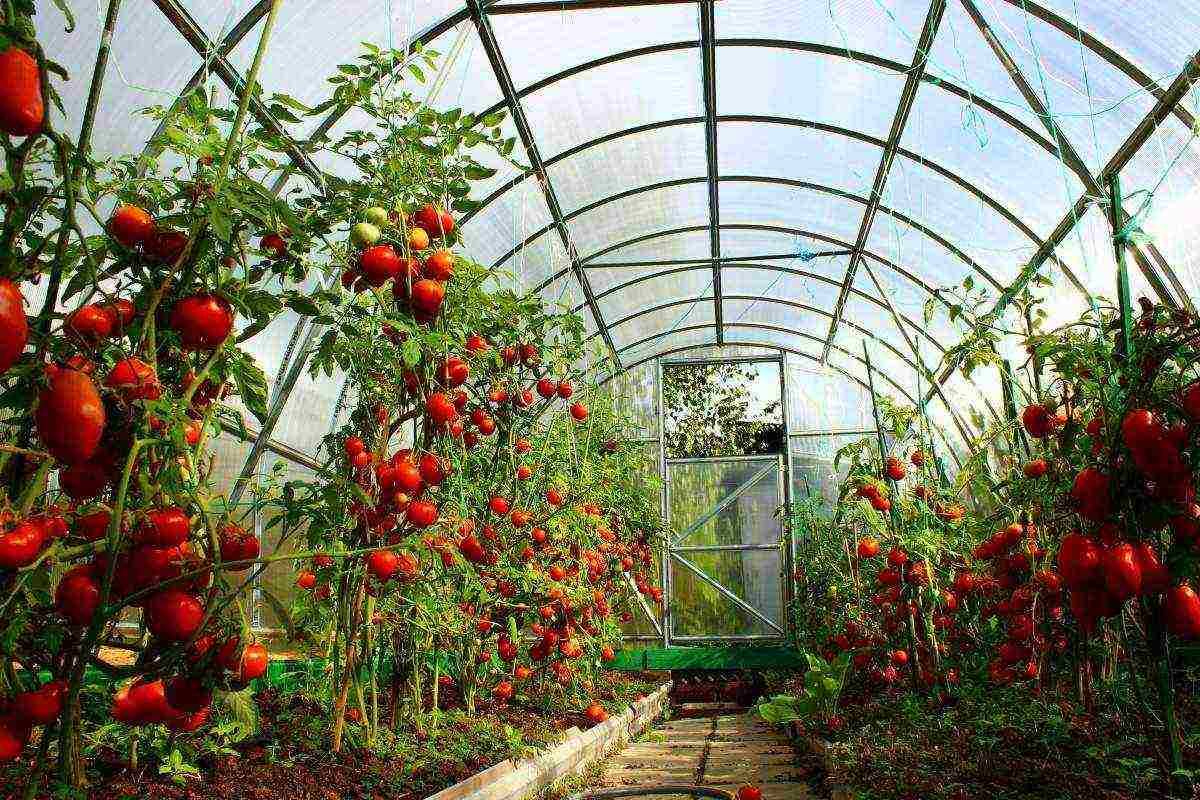
Tomatoes need diametrically opposite conditions: dampness and lack of regular ventilation will lead to the development of late blight, brown spot, gray mold and powdery mildew, which is dangerous for tomatoes.
Tomatoes are rarely watered - once a week is enough - but abundantly, while it is important to supply water at the root so that it goes directly into the ground and does not evaporate into the air. Tomatoes do not like heat - at temperatures above 25 degrees, they noticeably slow down fruiting, which is why the greenhouse needs to be left open during the day and drafts should be arranged with the help of vents at the other end of the greenhouse.
Tomatoes do not need nitrogen fertilizers; for their normal development, other feeding is required - with the content of potassium and phosphorus.
Planting tomatoes and cucumbers in the same greenhouse leads to a rather problematic situation: trying to satisfy the needs of both crops, you thereby destroy them or reduce yields. Dampness and high humidity in the greenhouse lead to a decrease in the immunity of tomatoes and an arrest of their growth. In such conditions, tomatoes are almost always affected by late blight.In addition, the pollen becomes wet, the inflorescences are not pollinated, which means that new ovaries will not appear.
If you strive to create favorable conditions for tomatoes, this will lead to a decrease in the yield of cucumbers. Dry air, lack of constant watering, frequent ventilation and drafts cause not only a slowdown in the growth of lashes, but can also completely ruin the plant.
How to find a compromise if there is no way to plant tomatoes and cucumbers in different greenhouses? It is still possible to grow these crops together, and there are several ways to do this.
Selection of varieties for combined plantings
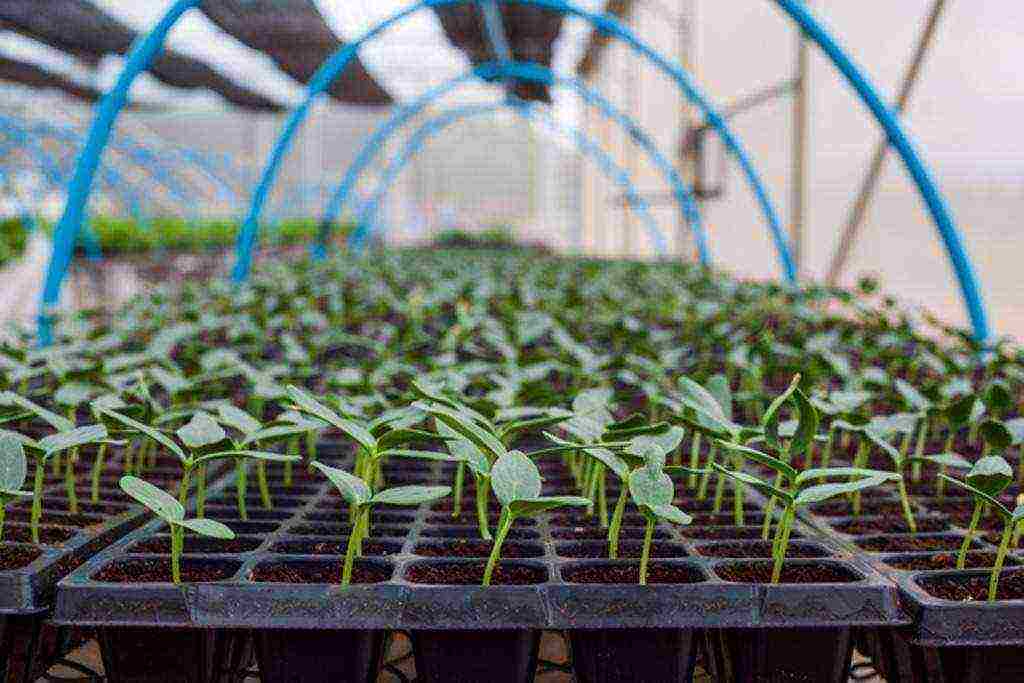
To successfully grow tomatoes and cucumbers in one greenhouse, you should carefully choose the seed.
For joint planting, you should select such tomatoes that are resistant to late blight and are not afraid of high humidity:
- "Dubok";
- "Dubrava";
- De Barao Blacks;
- "Dwarf";
- "Lark";
- "Tsar Peter";
- "New Year";
- "Blizzard";
- Soyuz 8;
- "La la fa".
These hybrid varieties bred by agronomists and created have strong immunity and are resistant to late blight and other diseases that tomatoes are exposed to due to high humidity conditions. Of course, the selection of such seeds will not completely eliminate the problems associated with the joint cultivation of different crops, but you will have a chance to preserve all the plants and get a harvest.
In addition to buying tomato seeds protected from late blight, you should also take care of the choice of cool-resistant cucumber varieties. Insufficient air temperature can cause a whole list of specific diseases in this capricious culture - rot, powdery mildew, bacteriosis and anthracosis.
It is dangerous that these diseases can be transmitted to tomatoes, then, trying to create comfortable conditions for tomatoes, you can lose all the plants in the greenhouse and your future harvest.
Agronomists have developed a lot of varieties of cucumbers that are resistant to diseases and suitable for growing in the open field:
- "Benefit";
- "Crane";
- "Princess";
- Leandro;
- "Thumb Boy";
- "Masha";
- "Goosebump";
- "Natalie";
- Pasadena;
- "Diva";
- "Nightingale";
- "Sister Alyonushka".
By choosing such varieties and hybrids of cucumbers that are resistant to cold and diseases, you can not worry about creating a specific microclimate for plants - they can optimally transfer the ventilation of the greenhouse, which is necessary for the normal development and pollination of tomatoes.
How to plant correctly?
For optimal growth and development of neighboring crops, it is important not only to select the seed, but also to plant the plants correctly. The location of cucumbers and tomatoes in the same greenhouse requires taking into account the peculiarities of the microclimate inside the greenhouse.
Separation

Gardeners most often use the crop separation technique when planting cucumbers and tomatoes in the same greenhouse. Their physical delimitation in the greenhouse area helps to avoid overflow of tomatoes and protects the whip from drafts.
As a rule, all greenhouses are installed in a west-east direction. This orientation provides optimal illumination of all crops from the south side.
Depending on the width of the greenhouse, 2-3 longitudinal beds are arranged in it:
- Cucumbers are planted in the northern bed. Here they will not dry out by the sun, and water will not evaporate into the air so intensively during irrigation.
- Tomatoes are planted in the central garden bed. There will be fresh air necessary for their comfort and pollination when ventilated.
- In the southern garden it is preferable to grow greens or eggplants. It will be too hot for tomatoes and too dry for cucumbers.
Since the soil in the greenhouse is a single whole, before planting seedlings and seed, you should attend to the demarcation of the soil. Sheets of roofing material or iron are dug in between future beds - such a measure will protect tomatoes from waterlogging with frequent watering of cucumbers and will allow you to apply fertilizers intended for each crop.
Zoning
Zoning is perhaps the most effective and optimal way to organize the space inside the greenhouse when growing different crops. This technique allows you to maintain the microclimate necessary for tomatoes and cucumbers in each part of the greenhouse.
The greenhouse is usually zoned across, dividing it into two functional parts.
There are two ways to make a partition:
- Capital method. A partition is made of cellular polycarbonate inside the greenhouse. The entrance to this compartment can be made both in the created "wall", and on the other side of the greenhouse.
- Fast way. The space inside the greenhouse can be delimited by hanging a curtain made of double-folded dense film on a stretched string or rod.
When zoning the greenhouse space, one should not forget about the separation of the soil: dig a sheet of roofing material, iron or a piece of polycarbonate of a suitable size into the ground at the border of the crops. It is recommended to put a tank with water in the "cucumber compartment" - it will not only serve for irrigation, but also additionally humidify the air in the separated area.
Hydrogel
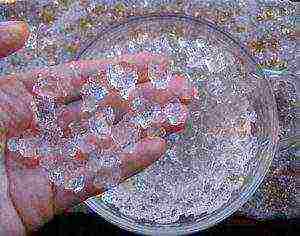 When growing tomatoes and cucumbers together, hydrogel becomes a real salvation for many gardeners.
When growing tomatoes and cucumbers together, hydrogel becomes a real salvation for many gardeners.
A modern adsorbent perfectly eliminates the problem of waterlogging of the soil and air - the crystals almost instantly absorb water during irrigation and give it to the roots of moisture-loving plants as needed.
Since water is absorbed by the hydrogel, during watering, there is no intense evaporation of moisture into the air and the humidity in the greenhouse does not increase. Thus, the use of an adsorbent does not reduce the immunity of a tomato, and at the same time provides cucumbers with the necessary liquid - both neighboring crops are comfortable.
When planting cucumber seedlings, it is enough to add about 0.5 cups of ready-made hydrogel to the hole, spill abundantly and then dig in the plant in the swollen granules. Most often, seeds are sown in a greenhouse - in this case, an organized hole with a sorbent is sprinkled with 5 cm of soil, and the prepared material is sown into the ground.
The hydrogel is convenient because it absorbs not only water, but also mineral fertilizers dissolved in it. If you soak the granules in a weak fertilizing solution before the first use, you can not worry about the nutrition of the cucumbers for a long time.
Mulch
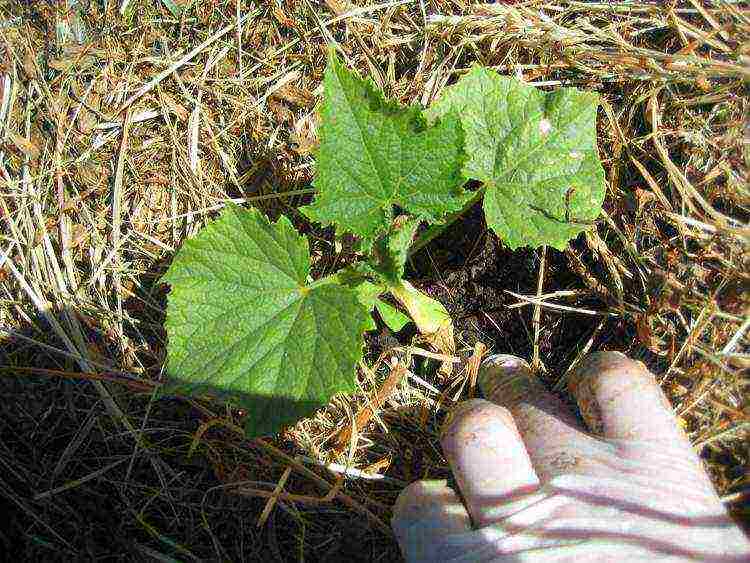
If you have already sown cucumbers in the greenhouse and it was not possible to add the hydrogel to the soil in time, you can use the mulching method. This method also helps to retain moisture at the plant roots and prevents excessive evaporation.
How to use mulch correctly:
- Prepare grass clippings or weeds that have been weeded out.
- When the seedlings sprout and the cucumbers release a real leaf, the soil around them is covered with a thick (8-10 cm) layer of mulch.
- As the layer subsides, it should be raised to the previous level of 10 cm.
Mulching allows you to reduce the number of water-loving plants, in addition, the gradually decaying lower layer releases heat, which cucumbers love so much, and nutritious organic fertilizers that are important for the development of any crop. Moisture from the soil will evaporate not into the air of the greenhouse, but under a dense mulch, creating a comfortable microclimate under each plant.
Growing cucumbers and tomatoes together in a greenhouse is undesirable, but still possible. The main thing is to divide the cultures and create for each of them the most comfortable conditions for development and fruiting.
Read: 570
It is possible to grow tomatoes and cucumbers together, but this will create certain difficulties.
Cucumbers and tomatoes are those crops that are found on the site of every gardener... They are grown in open and closed ground. Every gardener strives to get as much harvest as possible, but for this the plants must be provided with the most favorable conditions, which, often, can only be created in greenhouses.Therefore, it turns out that you can get a large harvest of tomatoes and cucumbers only if you grow them indoors.
But what to do: "Grow cucumbers and tomatoes in different greenhouses? Or you can grow tomatoes and cucumbers indoors together? And if so, how? ”It is worth saying that tomato and cucumber are two opposite cultures. Each of them requires special conditions, soil composition, etc. It follows that it is impossible to grow tomatoes and cucumbers together. But is it?
What do tomatoes like?
Tomatoes in the greenhouse
Tomatoes are plants that need dry air. If the air is humid, then they begin to suffer from various diseases that are very dangerous for them. For example, late blight. It is greenhouse tomatoes that suffer from it more often than those that are cultivated in the open field. The reason for this is the high humidity in the greenhouse. An infected plant can hardly be saved. You can only prevent the occurrence of this disease by reducing watering. Therefore, in the greenhouse, tomatoes are rarely watered, 2-3 times a week and with extremely warm water. When watering, in no case should water fall on the foliage and stems of the plant, otherwise the above-described disease will occur. Watering should be carried out early in the morning so that the humidity level in the greenhouse decreases until the evening, in order to prevent the tomatoes "sleeping" in the air with high humidity.
When growing tomatoes in a greenhouse, you need to take care of regular ventilation.... The air must be constantly or almost constantly in motion. It will also help prevent fungal infections on tomatoes.
Tomatoes need chernozem soil with a high content of organic and mineral substances, especially tomatoes value phosphorus, potassium and nitrogen. The soil should retain moisture well, but not allow it to stagnate.
What do cucumbers love?
Cucumbers in the greenhouse
Cucumbers need a lot of moisture... Their leaves evaporate a huge amount of moisture, and if the air in the greenhouse is dry, then the roots simply will not have time to absorb the required amount of water, which means that the leaves will wither. Cucumbers need humid tropical air, therefore, if it is very hot in the greenhouse (and this is often the case) they try to humidify the air with all their might. For this purpose, the walls of the greenhouse are poured with water, the paths and soil around the cucumbers are poured.
Cucumbers do not tolerate airing... They love "stagnant", heavy air. If the greenhouse is regularly ventilated, then the cucumbers will suffer greatly, look stunted and sick, and their fruits will be of poor quality, the yield will be significantly reduced.
This plant grows well on soils rich in humus, mineral and organic substances. Soils for cucumbers should retain moisture well, even create stagnation.
As we can see, tomato and cucumber are very different in their needs. So what can you do? Is it really necessary to build two different greenhouses, one specifically for tomatoes and the other for cucumbers?
The unequivocal answer is yes. But, you can try grow tomato and cucumber in the same greenhouse... This will take a lot of work.
You can make a kind of partition in the greenhouse that will separate the area in which tomatoes grow from the area with cucumbers... An ordinary polyethylene film stretched over a fishing line can serve as a partition. This will allow tomatoes and cucumbers to be grown in the same greenhouse, but they will not interfere with each other. Thanks to this method, you can easily create a suitable environment for them. The area with cucumbers can be well moistened, practically not ventilated, and the area with tomatoes, on the contrary, can often be ventilated and create dry air, rarely and in small quantities watering the plants.
It is also possible to grow these two crops in the same greenhouse without creating any partitions. But you have to constantly monitor the level of humidity and temperature, as well as determine the optimal level of ventilation in the room.To do this, you will have to purchase special equipment that allows you to perform these operations quickly and with high accuracy. This method is not very good, as it is not entirely expedient, but if you have a serious attitude, you can try it.
Another method is to plant in the greenhouse not only tomatoes and cucumbers, but also other crops.... For example, various greens: salad, dill, parsley, cilantro, etc. The greens will create additional moisture for the cucumbers, but without creating problems for the tomatoes. You can plant the closest relative of tomatoes: pepper. But, nevertheless, greens are preferable. It is worth saying that this method really works, but it is not very effective.
Conclusion on the joint cultivation of cucumbers and tomatoes
It is possible to grow tomatoes and cucumbers together, but this will create certain difficulties. The above methods are suitable for those who are not ready to build several greenhouses in their area or do not want to grow cucumbers or tomatoes in the open field. Still, tomatoes are not the best neighbors for cucumbers, and cucumbers, in turn, are not the best neighbors for tomatoes. Therefore, these two completely different crops should be grown separately.
In addition, I would like to say that it is better to grow tomatoes in a greenhouse, but cucumbers grow well in the open field.... If you want your cucumbers to also grow indoors, then you don't have to build a large greenhouse for them. It is enough to erect a small structure of plastic or metal arcs, and cover it with a covering material or ordinary plastic wrap. The same structure can be covered with polycarbonate, then you get a small greenhouse, specially created for cucumbers, which will last more than a year. In the spring, this structure can be used as a greenhouse in which seedlings of tomatoes, peppers, eggplants and other vegetable crops, as well as flowers, will be planted.


